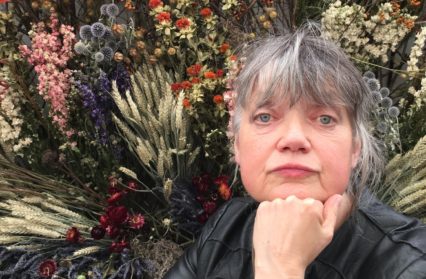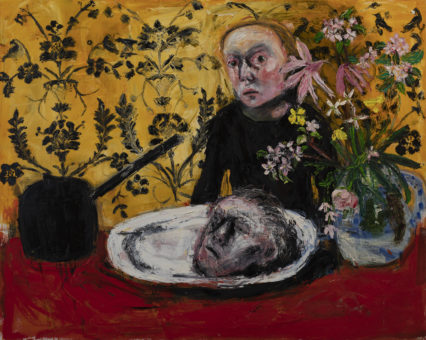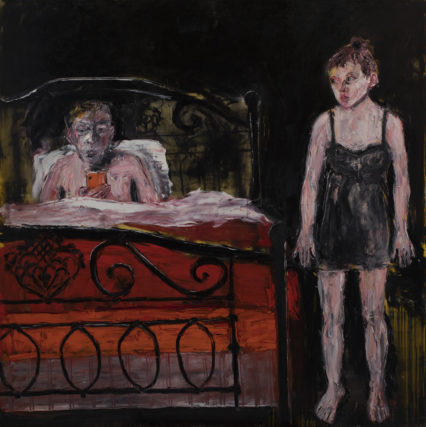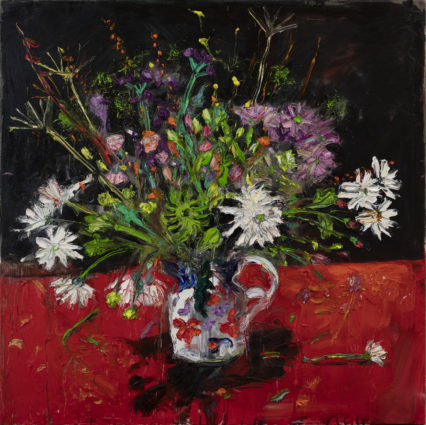Shani Rhys James is one of the most admired artists of her generation, with a career that has marked her out as a striking single-minded individualist. Lockdown and family tragedy has inspired her latest exhibition at Connaught Brown in Mayfair. Gary Raymond caught up with her from her home in mid-Wales via zoom.
Gary Raymond: How have you been? Have you managed to get out and about a little bit?
Shani Rhys James: Not really, no. I’ve been a bit obsessive about social distancing, and we’ve been here in quite an isolated situation, really. So, it’s been okay, because actually, it’s no different from usual, Gary, because literally, why are we here? Why are we here in Wales, in the middle of five acres, by a river, with trees all around, in the first place, having retreated from London? We found this place so that we could just get on with work [Shani’s husband is artist Stephen West]. And it’s been quite lovely because I’ve just been doing the work, but very aware also of the kind of weird, political, crazy situation that’s going on, and the fearfulness of it all.
Gary Raymond: So, your working conditions weren’t disrupted for this new exhibition?
Shani Rhys James: Not at all. The work that I did for this exhibition and the idea of Self Island is really about how we are psychologically all having to take on board that sense of isolation. A lot of us are not used to it, a lot of us are very social animals, going out, mixing at parties. We, as artists, are always in that state anyway. But there is that sense of lack of being near the family and not being able to see grandchildren. We’ve had the bubble with my parents but then my mother died during the pandemic. She didn’t die of COVID, but she had a stroke, and for four years she’d been in a wheelchair. And now my stepfather is not well, so we have to shield with him and that’s trapped us in this kind of sense of caring. But the awareness of death, really the awareness of vulnerability, the awareness of mortality, it really does bring it home to you when you have to put somebody in the ground. It’s a real wake up call.
The surreal thing is on the news you have ‘140,000 deaths. And now let’s go to the weather…’ and you want to scream, ‘Well, hello, you know you’re talking about individuals here?!’ It’s like mass genocide. And yet, it’s become almost normal, it’s almost become like the Vietnam War where people became inured to death. And that’s what’s frightening, I think it’s the acclimatisation to suffering really, the way it can be treated with such banality or treated with such casualness.
Gary Raymond: I wonder if this is when many artists should come into their own, as you’ve done, addressing these subjects with new work, because the nature of most creativity is that it’s a solitary act. An artist is already in the trenches, as it were.
Shani Rhys James: Well, I suppose you pick up on the Zeitgeist. You can either be an ostrich and completely hide away, or you can engage with the issues. I’ve been a bit of an ostrich as well as an engager. I understand the feeling of ‘I just have to go out there and just pick handfuls of flowers and just paint them because I’m going to go insane otherwise’. And it’s funny because as soon as my mother died, I did paint flowers. I thought, do I paint her, when she was dead? It is really weird seeing somebody like that because they’ve vacated the casement which is their body, you know, and it’s suddenly a vacuous thing. And that’s what’s been happening everywhere. People have been confronted with death. So, would I address the death that was so close to me? The families of one hundred and forty thousand people have had to deal with it. But we have had beauty, too. We have to be honest about this. We have had birds, we have had flowers, we have had a profusion of wild flowers like I’ve never seen before. And we have had silence and stillness; in a way, it’s kind of restorative, there’s a weird duality here where you have this horrendous tragedy, but at the same time, you have this restorative thing of silence and people not being able to drive. There’s also the awareness of climate change and the way that we are; the planet is just so threatened.
Gary Raymond: That’s really interesting, because there is that area of thought that nature will always correct itself, it will always protect itself and things like tsunamis and pandemics are ways of nature correcting something. In literary terms this is an idea of vengeance, but in scientific terms, it’s about a restoration of the balance, isn’t it?
Shani Rhys James: Yes, definitely balance, I think.
Gary Raymond: Some of your new work has been inspired by Boccaccio’s Decameron.
Shani Rhys James: At the beginning of the pandemic, Laura Gascoigne contacted me about this business of Boccaccio’s Decameron, because it’s about wealthy people going into the countryside to get away from the plague in the city. She had the idea of artists bringing their own interpretations to the stories in there. And there’s this interesting thing I found looking at the Decameron: the idea of a head on a platter, like John the Baptist, which has been used by many artists. But to us in the twenty-first century it’s quite shocking really to have a head on a platter. You can have a ceramic head on your sideboard, but you can’t necessarily have a painted decapitated head on a platter. Yeah. So I kind of thought, well, this is shocking. This is a shocking image.
I use the story of Isabella, whose brothers killed her lover. He was buried, he appeared to her as a sort of apparition, told her where he was buried, she dug him up, cut off his head, then brought it back and put it in a pot of basil. And then her tears made it grow profusely. These stories that the rich people escaping the city in Boccaccio’s stories told each other were all quite dark, but they seemed light too; there was a lot of was indulgence in food, sex, everything, but at the same time, there was a sort of dark undercurrent going on that kept on creeping into those stories.
Gary Raymond: So you responded to the dark undercurrent in some of the stories?
Shani Rhys James: Yes. Although maybe they’re more than an undercurrent.
Gary Raymond: You found something in the tone that you wanted to pick out?
Shani Rhys James: Yes, I suppose so. There was another story which was about a woman fleeing from a man on a horse. She rejected him. It’s an apparition, and in it he kept on killing her. It’s a little bit like Solaris by Tarkovsky, where the wife keeps on committing suicide. So she keeps on and every time she’s killed and eaten by rottweilers. It’s a continual circle of her being mutilated and killed in the story. So, I saw the parallel really, of being in London, and the fearfulness as a woman, when you have the sense of when you’re attacked. So many women you can ask, ‘have you ever been assaulted?’ I’ve been attacked in London. On a building site. I started praying and he stopped. Most women feel very vulnerable in a city situation. This is why I found the parallel with the woman fleeing, with the nasty rottweilers like rock fire chasing her and a man with a stick coming towards her in the distance. Behind that you’ve got a kind of a derelict building site: she’s on wasteland, like in a city. And so I did that parallel as opposed to the painting that was done by Botticelli. Botticelli’s painting was very useful though, because he brought home things about the city and about death and about all sorts of things from that imagery, and what I’ve been painting here has been about isolation. You’ve got my painting of the girl sitting on a bed, but then you’ve got her partner in bed with his iPhone. And again, she’s isolated.
Gary Raymond: I was trying to think whether I’d seen anything like that before in your work. I mean, you’re often drawn to domestic scenes and there are always lots of domestic implements and props around, but correct me if I’m wrong, I think that’s the first iPhone that’s been in your work.
Shani Rhys James: It is actually, yeah. I put it in because Stephen has become addicted to the iPhone. As have I. And they are evil, because you can ask anything you like. Anything.
Gary Raymond: I do all the time. Yesterday a phrase came to mind, I can’t remember what it was now, but it was a phrase I have always used and suddenly I just wanted to know the etymology of it. So, I just looked it up on my phone, and twenty-four hours later, I can’t even tell you what it was. I wonder if there’s a relationship between how easy it is to access this stuff and how difficult it is to retain. Our brains are getting flabby.
Shani Rhys James: Too accessible? Could be. We [Shani and her husband] are both hooked on Facebook. I’m hooked on Instagram. I’m hooked on how many likes I get. It’s so pathetic. When I say, ‘I’ve only had forty ticks’ for my particular drawing, I get ‘Oh, really? Well, I’ve got a hundred and forty’, or I might say, ‘Well, I only got fifteen. I don’t know why I only got fifteen’. What do they not like about it? I think because we’ve all been so lonely during this whole time, even if you’ve got a partner you can actually feel quite alone because he’s locked on his iPhone, and you’re locked on your iPhone. And we’re all a bit spaced out. I think we’re all in shock. We’re all a bit traumatised. It’s like a bereavement I think.
Gary Raymond: There are very few artists that I can think of who elicit contradictory, profound reactions in the way you do. I find myself feeling very sad whilst laughing sometimes at your work. You have a relationship with theatre in your work, and it’s difficult to escape the Beckettian vibe in it.
Shani Rhys James: My mum was an actress. And my stepdad in Australia met her because he was a theatre director. He said to her, ‘You’d be brilliant as Winnie in Happy Days’. And I did my thesis on Beckett. I just love his black humour. And you know in Malone Dies, he’s got a stick, and he’s feeling the edges of his room.
Gary Raymond: I think sometimes, with this pandemic, we’re as good as living inside a Beckett novel.
Shani Rhys James: Absolutely. And if you’ve got a mother also in the bed, you know… ‘where’s my biscuit?’ My mum actually did play the mother in the dustbin in Endgame at the Liverpool Everyman.
Gary Raymond: When you sit down with an idea for a new piece of work, do you consciously draw on artists like Beckett? Or are these things just a part of you, and then you stand back and look, and you can appreciate how they have come about?
Shani Rhys James: I often think in terms of a tableau. I’m trying to think of my next; I’ve got a big seven foot by six foot in the studio. I build up to those images. I don’t do lots of preparatory drawings, like a lot of people do, I just go bang in and I never know quite what I’m doing. But I might have a kind of a tableau vision in my head of what I’m going to do. And often looking at other work can be very stimulating. You know, if you look through a book or you’re looking at Cranach or Rembrandt or Valazquez or looking at a Picasso.
Gary Raymond: What brought about that painting on the bed?
Shani Rhys James: Personal things really. I do have to feel things. You were there down in London when I did that last exhibition, This Inconstant State, and I had to absolutely insist that that painting, ‘Glass of Water’, was put in the exhibition. Originally Anthony Brown (the director) didn’t want it because it was about death. It was about my mother’s stroke. It was about vulnerability. Vulnerability is something that I wanted to paint about. And I would think of other paintings. I would think of Francis Bacon, who did that wonderful one on the bed. That’s an incredible painting.
Gary Raymond: My memory of This Inconstant State was that that painting with the glass of water was the centrepiece, everything was built around that image.
Shani Rhys James: I don’t always get my way, but I did with that one. I love public gallery exhibitions and when you do a private exhibition it’s a different animal.
Gary Raymond: Do you find it’s a completely different relationship with the curator or the owner or whoever’s putting the exhibition together when you’re engaging with a private exhibition as opposed to a public gallery?
Shani Rhys James: Oh, yeah, it is. It is. But I’m a bit ballsy in a way and I will not let them undermine my ability to show big work. I have been with Martin Tinney for almost thirty years, and he’s always put on big paintings of mine. They might not necessarily sell the big paintings, but they’re the things that really hold the exhibition together.
Gary Raymond: I know we touched on flowers earlier, but I’m interested in the position of the ‘Gladioli’ and ‘Flowers in a Gaudy Jug’ in the catalogue. One is from 2019 and one from 2021, different ends of the pandemic. I wanted to ask you what you feel is the difference in those representations.
Shani Rhys James: Yeah, well, one’s quite cool, isn’t it in a way? It’s quite calm; whereas the other one is, well…
Gary Raymond: ‘Flowers in a Gaudy Jug’ is more visceral.
Shani Rhys James: Those flowers were from the local shop. I’ve got all these flowers in the garden growing and they’re all quite wild and crazy. I’ve got enormous foxgloves. I’ve got these great big yellow flags. I’ve got wildflowers down the bottom field, which are all weeds, I suppose. But they’re all flowers. Every year I paint them. That’s really what started me off actually.
Gary Raymond: Do you go into a new piece of work with some research under your belt? Or is it more instinctual?
Shani Rhys James: I’d say more instinctual, really. For that whole Decameron thing I did go into the research of it all, I read the stories and researched the imagery and things like that.
Gary Raymond: How do you prepare yourself to engage with something like the Decameron?
Shani Rhys James: I do like those big subjects. In France I’ve done these great big drawings of the raft of the Medusa. And then I did Pandora’s iPad which had all these images coming out of it, Bosch-like. And preparation is always different. It might be triggered by looking at a book, or it might be triggered by an exhibition. We used to go to so many exhibitions. I’d go to London and spend three days there, going into all the exhibitions; I haven’t done that for eighteen months. I used to just love going to lots of exhibitions.
Gary Raymond: They would inspire you?
Shani Rhys James: Yes. And also I’m inspired by people. My mother, because she used to upset me. She could say such cruel things. And the anger you get from something like that is a real stimulus, perverse as it might sound.
Gary Raymond: Do you find the flower paintings act as a good baseline for you? If you’re looking for inspiration you’ve always got the flowers to go back to.
Shani Rhys James: ‘I’ve always got the flowers…’ That could be a good title for the next exhibition. It’s like when Winnie says in Beckett’s Happy Days, ‘there’s always the bag’, but what she’s meaning is there’s always a gun. The daughter of James Joyce was a schizophrenic, wasn’t she? She was in love with Beckett.
Gary Raymond: Lucia. After Beckett rejected her advances she went through a series of breakdowns. I think Joyce had a very difficult time coming to terms with what he perceived as his own failures as a father after that. And the fact that it was he who institutionalised her.
Shani Rhys James: But it’s funny how a lot of writers and poets have this institutionalised person in their lives. Think of TS Eliot’s wife, I think she inspired him with ‘The Waste Land’. And yet, she just had a hormone imbalance and he incarcerated her. And also Scott Fitzgerald, his wife was a dancer, too, and ended up in a mental institution. I think they’re attracted to this crazy kind of wayward thinking person, but at the same time, they are supposed to have to preserve themselves, because that person might be quite self-destructive.
Gary Raymond: I wonder if those examples are about control. What we’re talking about here is the cycle for an artist; at some point, all of those things that are going around inside your head have to be brought under control to become something, and you have to make some very difficult, sometimes painful, decisions about what you keep and what goes in order to have that control to actually create something significant out of the chaos of inspiration and compulsion.
Shani Rhys James: Have you ever read any Patrick White?
Gary Raymond: I love Patrick White. I actually have The Eye of the Storm on the shelf just behind me.
Shani Rhys James: (groans) That’s my mother. Elizabeth Hunter was my mum. But, I was going to say, have you ever read The Vivisector?
Gary Raymond: No, I haven’t.
SRJ: Because that’s about an artist who was meant to be Patrick. It’s brilliant, because the artist is seen as the vivisector. So, the artist is a person who will see something and think, ‘Well, that’s going to be raw but I will use it’. I am the same. My father shot himself, for example, and I have often thought that when I write my autobiography that would be the starting point. A bit like Camus: ‘Mother died today. Or maybe it was yesterday.’ And so you do this thing where you in a way exploit. You exploit suffering or pain, what you’re experiencing. I find it really quite uncomfortable. For example, was it a difficult thing or was it a dumb thing to actually paint my mother in the bed having had a stroke? There is that sort of sense of, you’re intruding upon something very personal and something very sacred, but at the same time, you’re opportunistic about it. And this is the thing with artists in a way; there’s a certain detachment that you have with any kind of pain you experience.
Gary Raymond: I wonder if we’re sort of skirting around the word ‘ruthless’. I have an editor I can have these conversations with when it comes to my writing – am I going to places I shouldn’t be going? Am I being unkind or ungenerous? Do you have to have that conversation with yourself? Or do you have somebody that you trust?
Shani Rhys James: I used to have my mother but actors are all narcissists. As my uncle, who is a psychologist and my mother’s twin, said, ‘Well, the thing about your mother is straight up she’s a narcissist. And our father was a narcissist. And well, I’m a bit of a narcissist myself’. And I thought, ‘Well, yeah, I suppose I am, too’. I mean, of course I am. Self-centred, and all the things that go with that. I take it on the chin.
Gary Raymond: You mentioned, though, the word ‘disconnect’.
Shani Rhys James: One has an emotional existence. The truth is I haven’t been painting since my mother died. I find it quite difficult to paint, which is weird. I don’t know why. I’m coming to terms with that, I suppose. April 5th she died. And I don’t want to be flower painting, but I feel that maybe it’s just going too far to do her dead. I’m feeling great compassion towards her, you know? I think the biggest mistake she probably made was coming to Wales and taking up being a farmer and then painting because really what she needed was the immediate action of an audience and she loved literature and she loved studying and that’s why I got her to do those automata because I thought it would bring us together. But of course, it was difficult because mother and daughter is often difficult and close. It was like living in a Greek tragedy all the time. Because being in Wales and painting wasn’t the theatre. She wasn’t exercising that part of herself. But she has been an enormous inspiration to me, because she was quite a special person, actually. She was an undiscovered person. She was better than a lot of these actors that you see. And she wasn’t a lovey, she was a bit difficult, a bit tricky, didn’t fit in, would get drunk and go a bit mad and say the wrong thing, and then alienate all the people she was meant to be sort of loving up to. She was perverse. She refused to play the game. And I just see her as a bit of a tragic character, really. And I often paint about it, because I see this horrible vulnerability of somebody and she’s sort of symbolic of a woman, not necessarily my mother, but symbolic of what often happens to women, that they have often been sidelined.
I feel it in myself. I went to an art school which was dominated by men who were doing abstract expressionism. And you were just picked, perhaps because you had long hair and a sweet little face, but not realising that you’re a human being who actually has a lot of expression inside you, and you’re going to bloody well not let those bastards knock you down. This is what you’re always up against, as an artist, and as a female artist it’s really difficult. I still get that. And being little, being small, having always looked younger than I was. And you just have to say, ‘I’ll show the bastards’ all the time, you know, and you have to be really feisty, but it’s very tough. Still.
Shani Rhys James’ latest exhibition, Hunan-ynysu : Self Island, is at Connaught Brown from 9th of June – 1st of July 2021 and can be viewed online here.
Gary Raymond is a novelist, critic, broadcaster, and editor of Wales Arts Review.






 Enjoyed this article? Support our writers directly by buying them a coffee and clicking this link.
Enjoyed this article? Support our writers directly by buying them a coffee and clicking this link.








